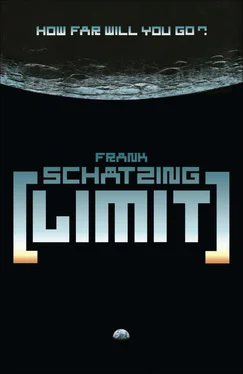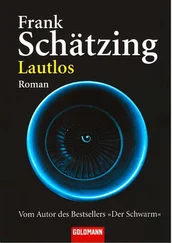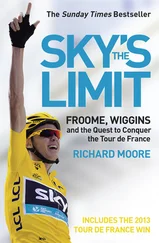‘If someone jumps in the air, it is one hundred per cent certain that he will fall back to the ground,’ screen-Julian explained. ‘Matter exerts gravity. The more mass a body contains, the greater is its field of gravity, with which it pulls smaller objects to it.’
Sir Isaac Newton appeared dozing under a tree, until an apple fell on his head and he leapt up with a knowing expression: ‘This is exactly,’ he said, ‘how the heavenly mechanics of all bodies works. Because I am bigger than the apple, you would imagine that the fruit would succumb to my very personal physicality. And in fact I do exert modest forces of gravity. But compared with the mass of the planet, I play a subordinate role for the apple, which is ripe for gravitational behaviour. In fact this tiny apple has no chance against Earth’s gravity. The more power I summon up in my attempt to throw it back up in the air, the higher it will climb, but however hard I try, it will inevitably fall back to the ground.’ As if to prove his remarks, Sir Isaac tried his hand at apple-throwing and wiped the sweat from his brow. ‘You see, the Earth pulls the apple right back down again. So how much energy would be required to sling it straight into space?’
‘Thank you, Sir Isaac,’ Julian said affably. ‘That’s exactly what’s at issue. If we consider the Earth as a whole, a rocket is not much different from an apple, even though rockets are, of course, bigger than apples. In other words, it takes a massive amount of energy for it to be able to launch at all. And additional energy to balance out the second force that slows it as it climbs: our atmosphere.’
Rocky Rocket, exhausted by his efforts to reach his celestial beloved, walked over to an enormous cylinder marked Fuel and drank it down, whereupon he swelled up suddenly and his eyes burst from their sockets. By now, however, he was finally in a position to produce such a massive explosion of flame that he took off and became smaller and smaller until at last he could no longer be seen.
Julian wrote up a calculation. ‘Leaving aside the fact that the size of the fuel tank required for interstellar spaceships becomes a problem after a certain point, in the twentieth century each new launch cost a phenomenal sum of money. Energy is expensive. In fact, the amount of energy required to accelerate a single kilogram to flight velocity sufficient to escape the Earth’s gravity was on average fifty thousand US dollars. Just one kilogram! But the fully crewed Apollo 11 rocket with Armstrong, Aldrin and Collins on board weighed almost three thousand tonnes! So anything you installed on the ship, anything you took with you made the costs – astronomical . Making spaceships safe enough against meteorites, space junk and cosmic radiation looked like a wild fantasy. How could you ever get the heavy armour up there, when every sip of drinking water, every centimetre of leg-room was already far too expensive? It was all well and good sharing a sardine-tin for a few days, but who wanted to fly to Mars in such conditions? The fact that more and more people were questioning the point of this ruinous endeavour, while the bulk of the world’s population was living on less than a dollar a day, was another exacerbating factor. Given all these considerations, plans such as the settlement and economic exploitation of the Moon or flights to other planets seemed an impossible dream.’ Julian paused. ‘When in fact the solution had been sitting on the table all the time! In the form of an essay written by a Russian physicist called Konstantin Tsiolkovsky in 1895, sixty-two years before the launch of Sputnik 1.’
An old man, with cobweb hair, a fuzzy beard and metal-rimmed glasses, stepped onto the virtual stage with all the grace of an ancient Cossack. As he spoke, a bizarre grid construction rose up on the Earth’s surface.
‘What I had in mind was a tower,’ Tsiolkovsky told the audience, hands bobbing. ‘Like the Eiffel Tower, but much, much higher. It was to reach all the way to space, a colossal lift-shaft, with a cable hung from the top end that was to reach all the way to the Earth. With such a device, it seemed to me, it would surely be possible to put objects into a stable terrestrial orbit without the need for noisy, stinky, bulky and expensive rockets. During the ascent, these objects, the further they go from the Earth’s gravity, would be tangentially accelerated until their energy and velocity are sufficient to remain at their destination, at an altitude of 35,786 kilometres, in perpetuity.’
‘Great idea,’ cried Rocky Rocket, back from his lunar pleasure-trip, and circled the half-finished tower, which immediately collapsed in on itself. Tsiolkovsky trembled, paled and went back to join his ancestors.
‘Yeah.’ Julian shrugged regretfully. ‘That was the weak point in Tsiolkovsky’s plan. No material in the world seemed stable enough for such a construction. The tower would inevitably collapse under its own weight, or be torn apart by the forces exerted upon it. It was only in the fifties that the idea regained popularity, except that now people were thinking about firing a satellite into geostationary orbit and lowering a cable from there to the Earth—’
‘Erm – excuse me,’ Rocky Rocket cleared his throat.
‘Yes? What is it?’
‘This is embarrassing, boss, but—’ The little rocket blushed and awkwardly scraped its stubby fins. ‘What does geostationary mean exactly?’
Julian laughed. ‘No problem, Rocky, Sir Isaac, an apple, please.’
‘Got it,’ said Newton, and slung another apple in the air. This time the fruit sped straight into the air, showing no signs of falling back again.
‘If we imagine that the Earth and similar bodies aren’t there, no gravity is exerted on the apple. According to the impulse that accelerated its mass when thrown by Sir Isaac Newton’s muscles, it will fly and fly without ever coming to a standstill. We know this effect as centrifugal force. Let’s put the Earth back where it was, and now gravitation, which we’ve already mentioned, comes into play, to some extent counteracting centrifugal force. If the apple is far enough away from the Earth, the Earth’s field of gravity has become too weak to bring it back, and it will disappear into space. If it’s too close, the Earth’s gravity will pull it back. Now, geostationary orbit, GEO in short, is found at the exact point where the Earth’s force of attraction and centrifugal force balance one another out perfectly, at an altitude of 35,786 kilometres. From there, the apple can neither escape nor fall back down. Instead, it remains for ever in GEO, as long as it circles the Earth synchronously with its rotational velocity, which is why a geostationary object always seems to stand above the same point.’
The Earth spun before their eyes. Newton’s apple seemed to stand motionlessly above the equator, fixed to an island in the Pacific. It wasn’t really standing still, of course, it was circling the planet at a speed of 11,070 kilometres per hour, while the Earth rotated below it at 1674 kilometres per hour, measured at the equator. The effect was startling. Just as the valve of a bicycle tyre always stands above the same point on the hub when the wheel is turned, the satellite stayed in place, as if nailed up above the island.
‘Geostationary orbit is ideal for a space elevator. First for the stable installation of the top floor in a stable position, secondly because of the fixed position of that floor. So once it was clear that you would just need to lower a cable 35,786 kilometres long from that point and anchor it to the ground, the question arose of what loads such a cable would have to support. The greatest tension would arise at the centre of gravity, in the GEO itself, which meant that a cable would have to become either broader or more resilient towards the top.’
Читать дальше












